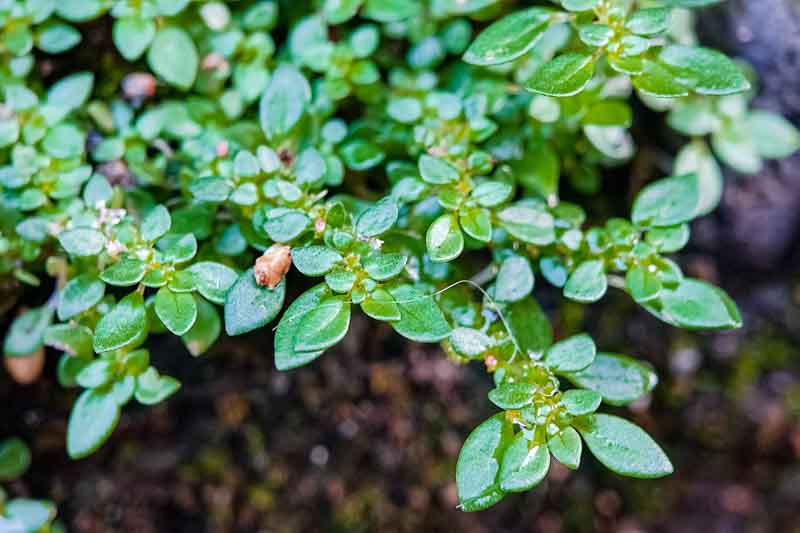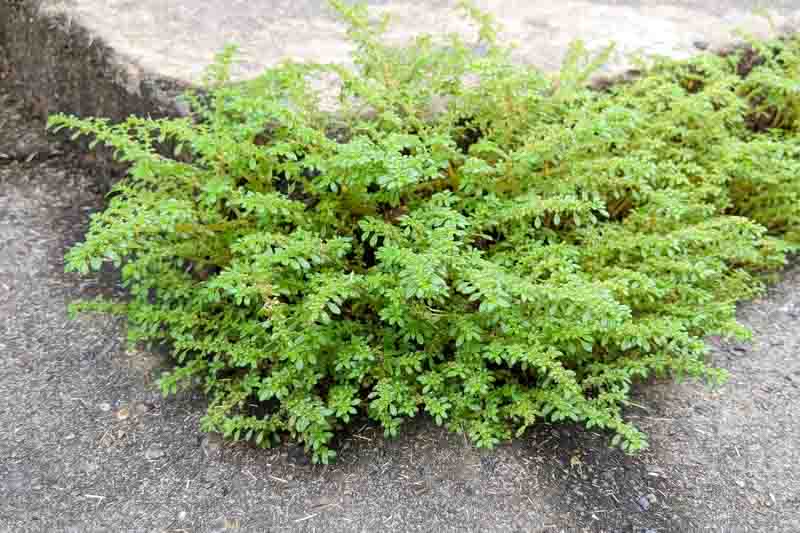Artillery Plant, Angeloweed, Rockweed
Pilea microphylla, commonly known as Artillery Plant or Rockweed, is a charming, low-maintenance plant that has captured the interest of gardeners and indoor plant enthusiasts alike. With its delicate appearance and intriguing reproductive mechanism, it offers various benefits and uses in various settings.
Pilea microphylla is characterized by its tiny, bright green leaves and fine, branching stems, which create a dense, moss-like appearance. It’s also known for the explosive pollen discharge from its minuscule flowers, earning it the nickname “Artillery Plant.”
Native: This plant is native to the tropical regions of Central and South America, where it thrives in warm, humid conditions. It belongs to the nettle family (Urticaceae) and is part of a diverse genus with over 600 species.
Plant Type and Habit: The Artillery Plant is an evergreen perennial plant with a creeping habit. In its natural habitat, it often spreads over rocks and other surfaces, forming a lush carpet.
Size: It generally grows to about 6-12 inches in height (15-30 cm) and can spread widely if given room, making it an excellent ground cover or pot filler.
Flowers: The flowers are extremely small and not particularly showy, but they are remarkable for their ability to “shoot” pollen into the air, a unique trait among plants. The plant produces tiny, inconspicuous fruits following flowering, containing small seeds.
Foliage: The main attraction is its dense, bright green foliage, which offers a vibrant splash of color and texture to garden beds, containers, and indoor spaces.
Hardiness: It is hardy in USDA zones 11-12 and is typically grown as an annual or indoor plant in cooler climates.
Uses: The Artillery Plant is used as an ornamental plant in rock gardens, terrariums, and as a ground cover in warm climates. It’s also popular as a houseplant due to its adaptability and ease of care.
Toxicity: Pilea microphylla is considered non-toxic to humans and pets, making it a safe choice for households.
Invasiveness: In tropical climates, it can become invasive if not managed, spreading rapidly across surfaces and through garden beds. It is considered an invasive species in many regions, including Australia, China, French Polynesia, Hawaii, India, Indonesia, Japan, and Singapore.
Benefits: Beyond its ornamental value, it is appreciated for its air-purifying qualities, helping to improve indoor air quality by filtering out pollutants.

Growing and caring for the Artillery Plant involves providing conditions that mimic its native tropical environment.
Light: The Artillery Plant prefers bright, indirect light. While it can tolerate some direct sunlight, too much can scorch its delicate leaves. A spot near an east or west-facing window, where the light is filtered, is ideal.
Soil: Use a well-draining potting mix rich in organic material. A mix designed for African violets can work well, as it ensures both moisture retention and good drainage.
Water: Keep the soil consistently moist but not waterlogged. Water when the top inch of soil feels dry to the touch. Pilea microphylla is sensitive to both over and under-watering, so finding a balance is key. Reduce watering slightly in winter.
Humidity: This plant enjoys high humidity but can adapt to average household levels. If your home is particularly dry, consider using a humidifier, placing the plant on a pebble tray filled with water, or misting the plant regularly to increase humidity.
Temperature: The Artillery Plant prefers temperatures between 65°F to 75°F (18°C to 24°C). Avoid placing it near drafts or heating and cooling vents, as sudden temperature changes can stress the plant.
Fertilization: Feed the plant with a diluted, balanced liquid fertilizer every 4-6 weeks during the growing season (spring through summer). Do not fertilize in the fall and winter when growth naturally slows.
Pruning: Pruning is not typically necessary but can be done to shape the plant or remove any leggy, sparse growth. This encourages a fuller, more compact plant.
Repotting: Repot every 1-2 years or when the plant has outgrown its current container. Choose a pot only slightly larger than the current one to prevent excess soil moisture, which can lead to root rot.
Propagating the Artillery Plant is straightforward and can be an enjoyable way to expand your collection or share with friends. Here’s a simple guide on how to propagate through stem cuttings:
Select and Cut Stem Cuttings: Choose healthy, vigorous stems from the parent plant. Using your clean scissors or pruning shears, cut a 2-4 inch piece of stem. Ensure each cutting has at least 2-3 leaves. If there are any leaves at the bottom part of the cutting, remove them to expose the nodes.
Prepare for Planting: (Optional) Dip the cut end of the stem in rooting hormone to encourage root growth. While not strictly necessary, this can help speed up the rooting process.
Plant the Cuttings: Fill small pots with a well-draining potting mix. Plant the cuttings into the soil, ensuring the exposed nodes (where you removed the leaves) are buried. Water lightly to settle the soil around the cuttings.
Create a Humid Environment: To maintain high humidity around the cuttings, you can cover the pots with plastic bags or place them under a propagation dome. Make sure to open the cover periodically to allow for air exchange and prevent mold growth.
Place in Indirect Light: Position the pots in a location with bright, indirect light. Avoid direct sunlight, which can be too intense for the young cuttings.
Monitor and Maintain Moisture: Keep the soil consistently moist but not soggy. The cuttings should begin to root within a few weeks. You can check for root growth by gently tugging on the cuttings. Resistance indicates root development.
Care for New Plants: Once the cuttings have established a strong root system and show new growth, you can begin to care for them as mature plants. This includes gradually acclimatizing them to normal indoor conditions and following standard Artillery Plant care guidelines.

The Artillery Plant is generally easy to care for, but like all plants, it can encounter pests, diseases, and common problems.
Spider Mites: These tiny pests can be identified by the fine webs they weave on the plant. They cause yellowing or speckled leaves. Increase humidity around the plant and wash it with a strong stream of water. For severe infestations, use insecticidal soap or neem oil.
Mealybugs: These white, cottony pests tend to cluster in leaf axils and under leaves, sucking sap and weakening the plant. Remove with alcohol-dipped cotton swabs or apply neem oil.
Scale insects: Hard or soft-bodied insects that attach themselves to the stems or leaves, causing yellowing and growth stunting. Scrape off with a fingernail or use a cotton swab dipped in rubbing alcohol. Insecticidal soap or neem oil may also be used.
Aphids: These small, green pests suck sap from new growth. Rinse them off with water or treat the plant with neem oil.
Root rot: Overwatering is the most common cause of root rot in Artillery Plants. Ensure the plant is in well-draining soil, and allow the top inch of soil to dry out between waterings.
Powdery mildew: A fungal disease that manifests as white, powdery spots on the leaves. It usually occurs in conditions of high humidity and poor air circulation. Improve airflow around the plant and reduce humidity if necessary. Fungicides can also be used as a treatment.
Leggy Growth: Insufficient light can cause the Artillery Plant to stretch towards the light source, resulting in leggy, sparse growth. Ensure it receives bright, indirect light for compact growth.
Yellowing Leaves: Overwatering, poor drainage, or nutrient deficiencies can cause leaves to turn yellow. Adjust watering practices, ensure good drainage, and consider applying a balanced, water-soluble fertilizer during the growing season.
Dropping Leaves: This can be a sign of either overwatering or underwatering. Check the soil moisture level and adjust your watering schedule accordingly.
| Hardiness |
11 - 12 |
|---|---|
| Plant Type | Houseplants, Perennials |
| Plant Family | Urticaceae |
| Genus | Pilea |
| Exposure | Partial Sun |
| Season of Interest |
Spring (Early, Mid, Late) Summer (Early, Mid, Late) Fall Winter |
| Height |
6" - 1' (15cm - 30cm) |
| Spread |
6" - 2' (15cm - 60cm) |
| Maintenance | Low |
| Water Needs | Average |
| Soil Type | Loam, Sand |
| Soil pH | Acid, Neutral, Alkaline |
| Soil Drainage | Moist but Well-Drained |
| Characteristics | Showy, Evergreen |
| Garden Uses | Ground Covers, Patio And Containers |
| Garden Styles | Gravel and Rock Garden |
| Hardiness |
11 - 12 |
|---|---|
| Plant Type | Houseplants, Perennials |
| Plant Family | Urticaceae |
| Genus | Pilea |
| Exposure | Partial Sun |
| Season of Interest |
Spring (Early, Mid, Late) Summer (Early, Mid, Late) Fall Winter |
| Height |
6" - 1' (15cm - 30cm) |
| Spread |
6" - 2' (15cm - 60cm) |
| Maintenance | Low |
| Water Needs | Average |
| Soil Type | Loam, Sand |
| Soil pH | Acid, Neutral, Alkaline |
| Soil Drainage | Moist but Well-Drained |
| Characteristics | Showy, Evergreen |
| Garden Uses | Ground Covers, Patio And Containers |
| Garden Styles | Gravel and Rock Garden |
How many Pilea microphylla (Artillery Plant) do I need for my garden?
| Plant | Quantity | |
|---|---|---|
| Pilea microphylla (Artillery Plant) | N/A | Buy Plants |
Create a membership account to save your garden designs and to view them on any device.
Becoming a contributing member of Gardenia is easy and can be done in just a few minutes. If you provide us with your name, email address and the payment of a modest $25 annual membership fee, you will become a full member, enabling you to design and save up to 25 of your garden design ideas.
Join now and start creating your dream garden!
Create a membership account to save your garden designs and to view them on any device.
Becoming a contributing member of Gardenia is easy and can be done in just a few minutes. If you provide us with your name, email address and the payment of a modest $25 annual membership fee, you will become a full member, enabling you to design and save up to 25 of your garden design ideas.
Join now and start creating your dream garden!